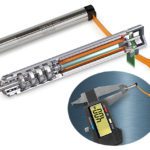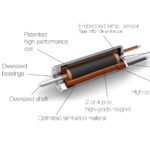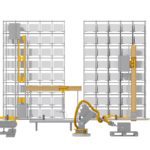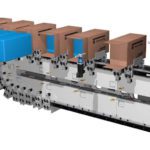Power transmission through gearsets is a mainstay of motion control, as gears allow full use of electric-motor capabilities. Recent years have brought gear innovations with new materials; custom gear variations; and all-new applications for helical, planetary, and strain-wave gearing. We asked several industry experts to share their thoughts these trends and the proliferation of OEM and end-user designs; here’s what they said.

What new uses for gears do you see in battery-powered designs and automated guided vehicles (AGVs), utility task vehicles (UTVs), and off-highway equipment?

Craig Van den Avont, president of GAM Enterprises: We’ve supported several applications for the drivetrain of AGVs. Because the size, shape, and application of AGVs are so varied, the drivetrain design has been unique for each application.
We’ve worked with each company to offer a solution tailored to meet specific requirements for both performance and cost. This has ranged from reinforcing the load-carrying capability of a design to engineering a gearbox that fits directly in the wheel hub. The wheel-hub design is interesting because it allowed for an extremely high load carrying capability to support the weight of the AGV.
We also have experience designing for robots that navigate rough outdoor terrain.
This application presents special challenges because the loads on the ATV wheels going over large rocks, curbs, and mud introduces shocks to the system that need to be taken into account.
One particular application initially seemed simple … but was actually quite demanding because of high-hit-rate shock loads. Collaboration between the engineering teams of GAM and the customer resulted in a robust system suitable to the environment and tailored to the application’s requirements.

What about the move towards mass customization — and the demand for value-added engineering services?
Brandon Steinberg of Portescap: We frequently integrate gearheads, shaft attachments, and custom connectors in motorized assemblies to eliminate components (and assembly tasks) for OEMs. That way, labor costs are lower and there’s less material overhead. Plus when motor experts control more of the assembly, it eliminates redundant steps … and allows retesting of motors after operations that sometimes introduce quality issues — pressing-fitting shaft attachments and recrimping wires, for example.

Van den Avont: Engineers are in short supply and are stretched thin with workload. We let engineers offload some of this work by giving them the option to collaborate with our application engineers — so they can design and configure the best solution for their needs. We also offer design manufacturing services for other components related to products we sell.
On a related note, the idea behind mass customization is to use an array of standard components and configure or combine them in various ways to yield unique solutions. We’ve used mass customization principles throughout our expansive standard gearbox range … with myriad available configurations in our gearboxes all based off of a standard set of core components. This lets us keep costs down while providing design engineers lots of options.
Dave Beckstoffer of Portescap: We engage with design engineers early in the product-development process to discuss design partnerships. Technology reviews at the concept phase give engineers better understanding of the impact design decisions have on the motion solution. Collaboration accelerates the motion subassembly timeframe to let engineers spend more time on the core value drivers of the new product … and customization can entail more than just the motor, gearbox, and encoder — even extending to additional mechanical components and subsystems that we as the manufacturer can fully assemble.
Van den Avont: Here’s a specific design example … Cartesian robots are very similar to gantry systems, which have been around for decades. Well, we see OEMs building their own Cartesian systems or buying them … so we offer a complete line of gearboxes and couplings products designed specifically for Cartesian robots. The idea is to make the system look sleek, get high-performance, and reduce costs for the manufacturer.
What are some materials used in today’s gear designs?
Eric Rice of Applied Motion Products: For applications demanding greater torque, users can equip our TSM11 StepSERVO integrated motors with planetary gearheads. PH planetary gearheads offer ratios from 4:1 to 22:1, with additional ratios available upon request. These planetary gearboxes feature an all-steel geartrain for long life.
Paul McGrath, national sales manager at maxon precision motors: Materials continue to drive gearmotor innovation. Case in point: maxon precision motors includes ceramic components in some of its precision gear assemblies so that either the gears themselves are ceramic or (more often) the shaft upon which the gears mount is ceramic. Metal shaft wear is often a problem, but advanced ceramic variations help gearboxes deliver higher speeds, higher torques, and longer life.
Warren Osak, CEO of Electromate: We see a few gearbox manufacturers replacing case-hardened and steel and alloy gears with ceramic gears … and ceramic shafts in gearboxes. Ceramic components exhibit little expansion so hold tighter backlash and runout tolerances than comparable internals made of metal. Ceramic components are also quiet, so gearboxes with ceramic internals are far less noisy than traditional gearheads.
Brian Dengel, general manager of KHK USA: Our carbon-fiber gears are another example of new uses for advanced material science in power transmission. We’ve made prototypes of carbon-fiber-reinforced plastic (CFRP), a material increasingly common in performance equipment and marine applications. While costly, CFRP gears are very light and usually much stronger than steel. KHK gears are of are of PA6/CF20% thermoplastic … and may soon offer a suitable option for gear applications in aerospace, drone, and automotive industries.

What customization to housings, ratios, resonant frequencies, outputs and inputs, and flanges is possible on gear products to satisfy application requirements?
McGrath: We now have laser-welding capabilities, so can weld custom gears — often third-party pinion gears — onto motor output shafts as a way to provide more complete solutions that easily integrate with gearboxes or other drive elements. Otherwise, OEMs must outsource this work or bond such gears to purchased stock motors.
Rice: Gears as value-add components are available for stepper motors as well. Our customers have always looked to us for components such as planetary gearboxes and encoders. In the last year, we’ve enhanced these offerings with the release of value-add components. PE and PH planetary gearheads cover nearly our entire range of motor sizes, from small NEMA 11 motors to larger NEMA 34 and 80-mm motors, and at competitive pricing.
Van den Avont: OEMs want solutions that meet their requirements and impart competitive advantage. Oftentimes, getting the best mechanical system performance means a unique design solution … But because price and delivery are paramount, OEMs don’t go with that technically ideal solution, opting instead to go with standard product.
So we’ve taken the concept of mass customization further. Based off our broad range of standard products (plus lean practices, flexible machinery, and AI in the workplace) we sell true custom solutions … even in small batches and at nearly the same price and delivery times as standard product. This lets engineers and end users get top system performance (and potentially trim design costs) without real sacrifice in service.

Describe the effect that online motion-component specification and purchasing has had on industry.
Van den Avont: Online product specification and configuration has become fairly common. An OEM should seek out suppliers who have configurators, because they save time (in large part by eliminating the need for 3D model creation). We give prospective customers the ability to size and select the proper product … and then configure it to match exactly what they’ll get — including all custom adapters and hardware. The customer then downloads the exact model and puts it into their machine design. We also have a mobile app that lets users custom configure product and then get a 3D model … along with pricing, specification pages, catalog pages, and installation instructions.







Leave a Reply
You must be logged in to post a comment.